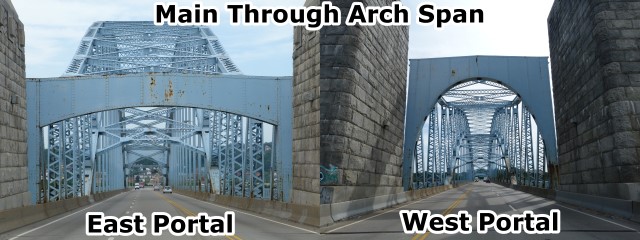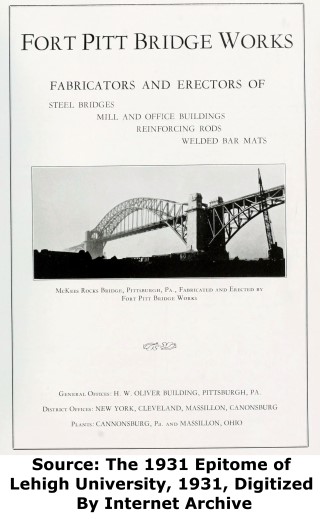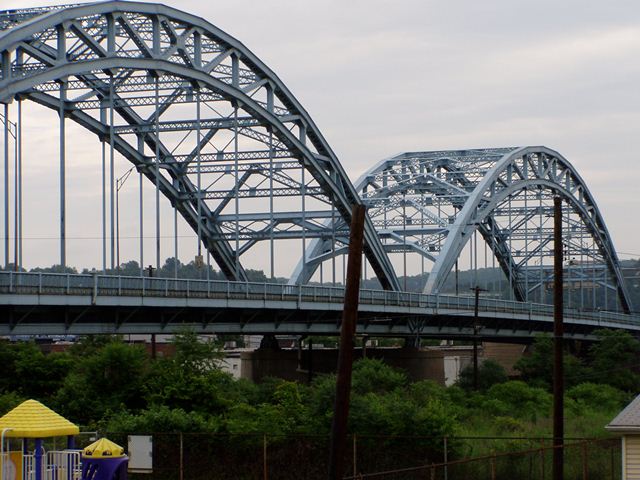We Recommend:
Bach Steel - Experts at historic truss bridge restoration.
BridgeHunter.com Phase 1 is released to the public! - Visit Now
McKees Rocks Bridge

Primary Photographer(s): Nathan Holth
Bridge Documented: June 2004 and July 1, 2014
Blue Belt (PA-3104) Over Ohio River, Railroad, and Various Streets
McKees Rocks and Pittsburgh: Allegheny County, Pennsylvania: United States
Metal 22 Panel Two-Hinged Braced Ribbed Through Arch, Fixed and Approach Spans: Metal 12 Panel Solid Ribbed Deck Arch, Fixed
1931 By Builder/Contractor: Fort Pitt Bridge Works of Pittsburgh, Pennsylvania and Engineer/Design: Allegheny County Department of Public Works
1987
750.0 Feet (228.6 Meters)
5,900.0 Feet (1798.3 Meters)
40 Feet (12.19 Meters)
1 Main Span(s) and 21 Approach Span(s)
23104003000000

View Information About HSR Ratings
Bridge Documentation
View Archived National Bridge Inventory Report - Has Additional Details and Evaluation
View Historic American Engineering Record (HAER) Documentation For This Bridge
HAER Data Pages, PDF
View Historical Book About This Bridge and Ohio River Boulevard
View Historical Articles About This Bridge
The McKees Rocks Bridge is one of the most unique bridges in a county filled with some of the most unique bridges in the country. www.PGHbridges.com calls this bridge a "pattern book on bridge types" and that could not be closer to the truth. The very long bridge stands out because of its variety of span types. The main span over the Ohio River is a braced rib through arch, often also called a "trussed" through arch. This is flanked by spandrel braced deck arch spans. West of all these spans are a series of Warren deck truss spans, that lead the bridge down to a concrete causeway-like structure that has a couple openings that function as grade separations. South of that somewhat unremarkable section of the bridge is the final set of spans, a pair of rare "crescent" arch spans, one of only a handful of known crescent arch bridges in North America. These spans are braced rib through arches, but the crescent name refers to how at the ends of the spans, the top and bottom chords of the arch rib come together, and essentially at the ends of the arch ribs, the ribs are solid ribbed as opposed to braced rib.
The variety of the spans on this bridge are what makes this bridge particularly noteworthy and significant. While the main steel arch span is significant, in some ways, the crescent arch spans are almost more significant because their design is more rare. To make a long story short, many of this bridge's spans would be significant historic bridges even if they were on their own as a single bridge, but together as one monumental bridge this is a very noteworthy historic bridge.
One of the most interesting aspects of the main through arch span is how the design accommodates the fact that the roadway runs at a 3% grade as it works it way east up to Ohio River Boulevard. Although the roadway runs at a grade, the steel through arch itself is not built to a slope, and is positioned horizontally. As such, there is substantially more distance between the deck and the top chord at the west end of the span. As a result, the portal bracing at the east end is a completely different design than the portal bracing at the west end. The western portal bracing has a very deep arch shape much like a half-oval, while the eastern portal bracing is a very shallow arch design. Similarly, the decorative pylon at the western end of the span is much taller than the eastern pylon. A side-by-side comparison of the two portal braces is offered below.

![]()
Photo Galleries and Videos: McKees Rocks Bridge
About - Contact
© Copyright 2003-2025, HistoricBridges.org. All Rights Reserved. Disclaimer: HistoricBridges.org is a volunteer group of private citizens. HistoricBridges.org is NOT a government agency, does not represent or work with any governmental agencies, nor is it in any way associated with any government agency or any non-profit organization. While we strive for accuracy in our factual content, HistoricBridges.org offers no guarantee of accuracy. Information is provided "as is" without warranty of any kind, either expressed or implied. Information could include technical inaccuracies or errors of omission. Opinions and commentary are the opinions of the respective HistoricBridges.org member who made them and do not necessarily represent the views of anyone else, including any outside photographers whose images may appear on the page in which the commentary appears. HistoricBridges.org does not bear any responsibility for any consequences resulting from the use of this or any other HistoricBridges.org information. Owners and users of bridges have the responsibility of correctly following all applicable laws, rules, and regulations, regardless of any HistoricBridges.org information.
![]()







